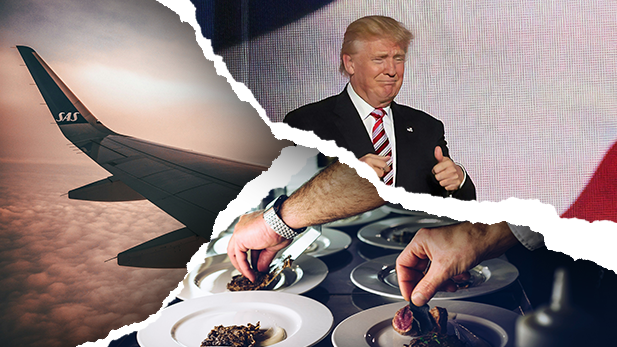Researcher: We purchase identity like never before

Photos: Unsplash by Dzmitry Dudov, History in HD and Fabrizio Magoni
Over the coming months, the American election will truly ignite. In practice it means, among other things, that Donald Trump will attack his political opponents no holds barred, and he will alienate segments of the American population along the way.
“Trump isn’t talking about politics, he’s talking about identity, and that’s why we often misunderstand him"
Mads Mordhorst, Associate Professor
Which may well seem a surprising strategy to many. But according to Associate Professor, Mads Mordhorst, who conducts research on branding and business history at CBS, Donald Trump knows exactly what he is doing. He is talking directly to our identity, and in order for that to be a successful strategy, you have to alienate others. In fact, commercial companies use a similar strategy when they compete for markets.
“Trump isn’t talking about politics, he’s talking about identity, and that’s why we often misunderstand him and consider him a little crazy. But he is very conscious of appealing to people’s understanding of self. The same is true for many of the big commercial companies. Their campaigns no longer focus on their products, but on identity,” Mads Mordhorst explains.
According to him, we also see this development in Denmark. We will, however, begin in the US, as that is the home of some of the best known examples.
NIKE LAUNCHED A CONTROVERSIAL CAMPAIGN
One example is Nike and their 2018 campaign, “Dream Crazy”, and according to Mads Mordhorst, there are several things to take note of.
The advertising campaign is centered on sixteen athletes who represent various minoritised positions. In addition to their athletic achievements, they have had to overcome prejudice and opposition. By way of example, we meet a woman Muslim boxer, a queer skateboarder and an American football player who is missing one hand.
We also meet famous Black athletes such as tennis player, Serena Williams, and basketball player, LeBron James.
During the segments, a voice over lets us know how their victories have helped them rise above their sport. “Don’t become the best basketball player on the planet. Be bigger than basketball,” as the soundtrack to LeBron James’ story informs us, while we watch him working for a charity, he founded.
“GET THAT SON OF A BITCH OFF THE FIELD”
“The voice over is interesting. It is Colin Kaepernick, a former quarterback for the San Francisco 49ers. In 2016, as the very first athlete, he chose to kneel during the national anthem before kickoff. It turned into a national movement and it became the symbol of Black Lives Matter,” the CBS researcher says before continuing:
“Football became the point of departure for a conflict on race and identity. A conflict between a primarily White audience and the players of whom the majority are Black. It was a conflict that Donald Trump quickly threw himself into. That year, he had won the presidential election with the slogan ‘Make America Great Again’, which appeals much more to the loss of greatness than to political projects.”
According to Mads Mordhorst, that was why Kaepernick’s protest became a perfect opportunity to mobilise that sense of a lost identity. During a Trump rally in Alabama, the newly elected President roared about the lack of respect for American heritage, the American flag and American values. And cheered on by his audience, Trump encouraged the football clubs to get their act together, and if they ever saw someone kneeling, they should “get that son of a bitch off the field”.
However, Kaepernick continued to kneel, and the following year, none of the clubs dared to sign him. He was out of a job, until he turned up as the main character in Nike’s new campaign. They consciously chose him because of his background.
NIKE-CAMPAIGN NEVER MENTIONED THEIR PRODUCTS
“Kaepernick became the incarnation of the slogan ‘Believe in something. Even if it means sacrificing everything’. He sacrificed his career in sports for the rights of Black people and thus, he became an icon in terms of identity. And that’s why he was such an obvious choice for Nike’s campaign,” Mads Mordhorst explains.
He adds that in many of the segments, we never see any of Nike’s shoes, and neither are they mentioned.
“So, we have a sports company that doesn’t sell sports. And a politician, who doesn’t sell politics. Instead, their focus is on identity, and both parties win. Nike creates a community of identity. And so does Trump,” Mads Mordhorst elaborates.
The fact that the campaign created a conflict in the population suited both parties perfectly, according to the CBS researcher. Encouraged by Trump, many – primarily White middle-aged men – started burning their old Nike shoes in protest. And yet, Nike’s stock price went up, and two years later, the company had all but doubled its value.
15 DOLLARS WORH OF IDENTITY
“Our search for an identity has never been greater
Mads Mordhorst, Associate Professor
According to Mads Mordhorst, that chain of events exemplifies the huge identity market that has emerged, where various actors compete for consumers. The companies compete in creating a narrative that will eventually make their products more meaningful.
“Our search for an identity has never been greater. We want a place to stand, but as opposed to earlier, we have to find it for ourselves. Previously, we had clear values such as the nuclear family, gender, class. But all that is changing drastically, and because of globalisation, the same goes for the nation state,” Mads Mordhorst explains.
“And even if we can’t walk into a shop and buy 15 dollars worth of identity, certain products and their narrative can help to fill a void. And as a result, areas such as politics, business, media and culture compete in the same market on offering consumers an identity,” he adds.
The prerequisite for success in this market, however, is linked to a controversial demand: difference of opinion. According to Mads Mordhorst, identity and community require clashes of interest. There has to be people who do not share the same values.
SAS WAS DIVISIVE
Nike and Trump were very aware of this. Florida’s Senator, Ronald DeSantis and Disney were also very aware of it when a few years later, they embarked on a controversy about the teachings on sexual and gender identity in primary schools. And perhaps SAS knew, when they launched the campaign: “What is Truly Scandinavian?”
“I believe that SAS was very deliberate in the planning of this campaign
Mads Mordhorst, Associate Professor
The latter is an advertisement film about Scandinavia. The message being that much of what we believe to be Scandinavia is actually imported from abroad. Among other things, the voice over tells us that Democracy comes from Greece, rye bread from Turkey and liquorice from China.
According to SAS, the campaign was meant to show that travelling and being inspired by others is a good thing. Yet, many perceived the message as provoking; SAS landed in a regular shitstorm, and the Danish People’s Party’s Søren Espersen publicly disowned the campaign. SAS immediately replaced the segment with a shorter and softer version.
“Yet, I believe that SAS was very deliberate in the planning of this campaign. It was a global narrative about Scandinavians wanting to travel and be inspired. The company calculated that it would be a provocative message, but also that their own target group would agree,” says Mads Mordhorst, before adding that SAS has since then changed their strategy and they are no longer competing in terms of identity, but rather in terms of price.
FRIED PORK ON THE PODIUM
The Danish population’s relationship to food is another area, which, according to the CBS researcher, has entered the identity market. By way of example, in 2014, then Minister of Food, Dan Jørgensen, launched a competition to decide which dish would become Denmark’s national dish. The winner was fried pork with parsley sauce.
At the time, there a discussion on Danish food culture had already begun, and once pork landed on the Minister’s top podium, there was a backlash.
“Claus Meyer headed a renewed interest in Nordic cooking. Danish Michelin restaurants also became the focus of attention, and in many restaurants, food is not merely eaten. It is narrated. The guests come for a shared experience and a shared identity, and this includes the story about the meal itself and the raw produce,” says Mads Mordhorst.
He is currently working on a book that will describe various areas of the identity market and their consequences. Among other things, the communities and differences in opinion that identity markets can create.
Contact:
Lektor Mads Mordhorst: mmo.bhl@cbs.dk
Journalist Kent Kristensen: kk.slk@cbs.dk
